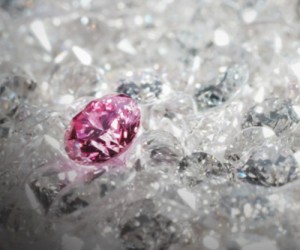London-listed Gem Diamonds on Monday lowered its 2013 production
guidance for the Letšeng mine, in Lesotho, to between 95-million carats
and 105-million carats recovered and sold, as tons of ore treated were
lower than planned, owing to the installation of the secondary and
tertiary cone crushers in the treatment plants.

In March, the firm’s guidance for Letšeng, in which the Lesotho
government holds a 30% stake, was between 115 000 ct and 130 000 ct
recovered and between 110 000 ct and 125 000 ct sold.
The installation of the crushers formed part of the company’s expansion
of Letšeng, known as Project Kholo, which proposed to increase
throughput to at least 10-million tons a year from 5.6-million tons a
year, doubling the yearly carat output to 200 000 ct.
The cone crushers in the treatment plants would increase revenue by
reducing diamond damage. The project was also aimed at improving
recovery, as well as reducing real operating costs of $2/t.
This expansion, together with the lower grade ore from the Main pipe
and mining in an area with high internal basalt content, resulted in
lower carats recovered.
CEO
Clifford Elphick said Gem Diamonds was focused on
moving mining operations at Letšeng mine to the higher value,
higher-grade Satellite pipe, which would boost revenue during the second
half of 2013.
The company said waste stripping progressed well during the period
under review, which would release Satellite ore for treatment in the
latter part of the second half of the year. Although higher-grade
recoveries were expected in the second half, Gem Diamonds pointed out
that it would not be sufficient to recover the full shortfall.
The company recovered 42 268 ct in the first half of 2013, down 26% on
the 57 234 ct recovered in the second half of 2012. Gem Diamonds sold 47
065 ct for $81.9-million, compared with 48 892 ct, which earned it
$82.6-million in the final six months of 2012.
A total of 249 ct, valued at a rough market value of $3.3-million were
extracted from Letšeng for manufacture through the group's operations in
Antwerp, in Belgium. Of the diamonds extracted, $1.1-million remained
in inventory at the end of the period, compared with $10.4-million at
the end of December last year.
The sale of polished diamonds from Letšeng contributed $4.9-million in
revenue, which resulted in additional earnings before interest, tax,
depreciation and amortisation of $3.5-million.
Elphick stated that Letšeng continued to demonstrate high quality,
following the recovery of three diamonds weighing in excess of 100 ct
each during the period under review. The miner sold a 164 ct white
diamond for $9-million; a 103 ct yellow diamond for $810 000; and a 100
ct white diamond for $6.45-million.
An average value of $1 741/ct was achieved for the first five tenders
of 2013, compared with $1 690/ct in the second half of 2012. Nine rough
diamonds achieved a value in excess of $1-million each, while 44 rough
diamonds achieved prices greater than $20 000/ct.
Meanwhile, Gem Diamonds' wholly owned subsidiary, Gem Diamonds
Botswana, is continuing the development of the Ghaghoo project and
completed the construction of the treatment plant, with commissioning
planned for the second half of 2014 to coincide with the ore becoming
available.
Mining support infrastructure, camp, treatment plant and other services
at Ghaghoo were in place and the first diamonds would be recovered in
the second half of next year. Thereafter, a steady state production rate
of 230 000 ct/y, at a mining rate of 720 000 t/y, was planned.
The group maintained its strong cash position, with $61.5-million cash
as at the end of June, of which $54.6-million was attributable to Gem
Diamonds.





















